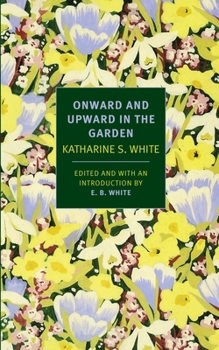Onward and Upward in the Garden
Select Format
Select Condition 
Book Overview
In 1925, Harold Ross hired Katharine Sergeant Angell as a manuscript reader for The New Yorker . Within months she became the magazine's first fiction editor, discovering and championing the work of... This description may be from another edition of this product.
Format:Paperback
Language:English
ISBN:1590178505
ISBN13:9781590178508
Release Date:March 2015
Publisher:New York Review of Books
Length:392 Pages
Weight:1.40 lbs.
Dimensions:0.9" x 5.1" x 8.0"
Customer Reviews
2 ratings
Wildflowers are God's gift
Published by Thriftbooks.com User , 20 years ago
There is a forward by E.B. White describing his editor, wife Katharine White. Katharine White was traditional by nature. She liked the flowers of her childhood. A neighboring estate near her house in Brookline, Massachusetts was owned by a prominent botanist named Sargent who founded the Arboretum in Boston. The children of the neighborhood were permitted to trespass and she claims that her sense of what was appropriate in terms of landscaping was formed at that time. Mrs. White refers to herself as a catalogue addict. She surveys the writing in the garden catalogues. She finds some catalogues growing more flamboyant. She does not like it that flowers are being made to imitate other flowers. Lilies are the most photogenic of all flowers she declares. In another essay she gives irises the same encomium. Nasturtium means nose twister in Latin. Writing about the garden catalogues is almost as wonderful as having a garden. Words and pictures serve as memory aids. Newly developed kinds of roses and other flowers create in the reader a sense of expectancy. Katharine White describes a process akin to marketing and, yes, fashion. In her essays Mrs. White lists a bewildering array of catalogues in all sizes and shapes. Many of the nurseries specialize in, say, daffodils. The golden age of flower painting was 1760-1860. The writer recalls the lawn of her childhood and the gentle mowing of it by hand. She finds the current practice of mowing with a gasoline powered mower noisy business. She is tempted to plant an apricot tree in memory of a Jane Austen squabble in MANSFIELD PARK. Katharine White points out that the Victorian garden is now despised, the kind that makes a carpet on the lawn, makes patterns. She writes that wildflowers are important because they are gifts from God or nature. The Japanese art of Ikebana is the art of flower arranging. No two people agree on the history and the techniques. Mrs. White received at an early age Lafcadio Hearn's GLIMPSES OF UNFAMILIAR JAPAN. Hearn was a reporter with an eye for beauty. Flowers have been a traditional offering to the Gods. Garden Club judges have a powerful influence on contemporary aesthetics. Most modern flower shows are built around a theme. Flower arranging is filled with fads and trends. Kitchen utensils as containers are much favored in New England country shows. The gardens at Winterthur have been opened to the public since 1951. There is a short review of V. Sackville-West's GARDEN BOOK. It can be read for the sheer pleasure of its prose style. A list of suppliers and books in print appears at the back of the book. In addition to reviewing garden catalogues, garden books, nature guides, and flower arranging books are covered.
Charlotte's Web...
Published by Thriftbooks.com User , 24 years ago
Did you ever wonder where Charlotte the spider lived? I can visualize Mrs. White working away in one of her gardens, E.B. reclining on a lawn chair. He dozes off, and when he wakes finds a lovely garden spider has spun it's web exactly over his head. "Charlotte" he exclaims! Mrs. White's articles were written several decades ago, and they reflect an era many cannot recall. (The median age of the U.S. population is about 30 so most residents were born after she wrote many of these articles.)This was an era of elegance, white gloves, hats, and ladies luncheons--though Mrs White also worked fulltime for the New Yorker Magazine. Mr. White muses in the forward to this book that when they lived at their Maine home, every day before noon Mrs. White would arrive from the cutting garden with mud-ringed Ferragamos and arrange flowers for the dining room table. Well, I would never abuse my Ferragamos, but it's lovely to bring fresh flowers from the garden into the house. Mrs. White had many uses for flowers. "Goldenrod...can be made into a crown of gold for a Harvest Queen or a necklace for a child." Her words evoke the more carfree days of a childhood when there were many fields about, and most children rich or poor could fashion a necklace of golden flowers. Riches indeed.In an age when many gardeners are overly concerned with design, Katherine White reminds us Nature creates much more visually beautiful spaces than mere mortals can, and perhaps we better work to save the remaining space. I've enjoyed the pieces Mrs. White wrote, and I am glad Mr. White took the time to compile them into one book.




